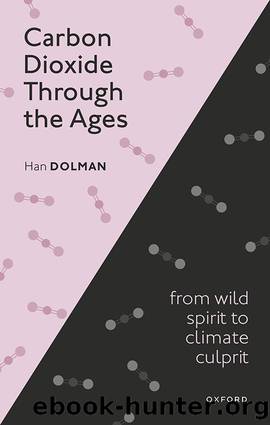Carbon Dioxide Through the Ages by Dolman Han;

Author:Dolman, Han; [HANDOL MAN]
Language: eng
Format: epub
Publisher: Oxford University Press, Incorporated
Published: 2023-02-09T07:33:35+00:00
Figure 8.1 Change in land cover in the past 10,000 years.
From Our World in Data
Converting forest land to cropland and grazing was aided by fire as an efficient clearing tool, but use of trees for timber started to play an increasing role in the deforestation of Europe. In particular, the next two centuries after the Black Death saw a further decline in forest area as timber was required to build towns, cities, cathedrals, and ships with which to explore the rest of the world. At the same time the worldâs trade became more globalized with the discovery of the Americas in 1492 and further exploration of the world in the Orient by the richer countries of Europe. In the seventeenth and eighteenth centuries large amounts of forest in the US were cleared by immigrants from Europe. Yet by 1700 only about 5% of the worldâs forest had been cleared. Between 1700 and 2018 (Figure 8.1), however, almost a tripling of that rate took place (14%). âThe power and progress of industrial technology radically altered the pace and nature of the life and livelihood of a large number of people, and the character of their society. Europe and its appendages overseas â North America, Australia, New Zealand, and selected parts of Latin America â rapidly followed suit. In Asia, Africa, and the bulk of Latin America, aspects of the same technology, coupled with exploitation and domination by Europeans, had equally dramatic and ultimately devastating effects, overturning ancient ways of life, opening the way for a new global economy, and unbalancing world relations. Everywhere, land cover and land use experienced a dramatic transformation, of which, perhaps, the forest was affected most of all, followed in time by changes in grasslands. It was, as we have said before, the biggest change to the vegetation of the world since the Ice Ageâ9. Part of the latter âprogressâ was undoubtedly associated with the availability of steam power to which we will come in an instant. At the beginning of the eighteenth century, forest clearing for agriculture (grazing and crops) took off more dramatically with the final result that we now have only 38%, roughly half, of the habitable land left as forest, with grazing and arable agriculture making up 36%. There is only 14% of wild grass and shrubland left, compared to 42% 10,000 years ago. In the process two billion hectares of forest, one third of the original cover, have been lost.
Trees contain carbon, so felling or burning them frees carbon. When timber is being used in building the release is slow as the structure slowly degenerates. When forest is burnt, the carbon is immediately released as CO2 into the atmosphere. In principle, if one knows the carbon content, multiplying it by the area gives the amount of carbon lost. In practice there is a little bit more to this calculation. Carbon density tends to vary with tree species such as between coniferous and deciduous. It also sits in the soil. To make historical reconstructions one also needs to estimate the rate of settlement and population growth.
Download
This site does not store any files on its server. We only index and link to content provided by other sites. Please contact the content providers to delete copyright contents if any and email us, we'll remove relevant links or contents immediately.
| Automotive | Engineering |
| Transportation |
Whiskies Galore by Ian Buxton(41536)
Introduction to Aircraft Design (Cambridge Aerospace Series) by John P. Fielding(32893)
Small Unmanned Fixed-wing Aircraft Design by Andrew J. Keane Andras Sobester James P. Scanlan & András Sóbester & James P. Scanlan(32579)
Craft Beer for the Homebrewer by Michael Agnew(17937)
Turbulence by E. J. Noyes(7708)
The Complete Stick Figure Physics Tutorials by Allen Sarah(7148)
Kaplan MCAT General Chemistry Review by Kaplan(6603)
The Thirst by Nesbo Jo(6444)
Bad Blood by John Carreyrou(6283)
Modelling of Convective Heat and Mass Transfer in Rotating Flows by Igor V. Shevchuk(6230)
Learning SQL by Alan Beaulieu(6041)
Weapons of Math Destruction by Cathy O'Neil(5842)
Man-made Catastrophes and Risk Information Concealment by Dmitry Chernov & Didier Sornette(5659)
Digital Minimalism by Cal Newport;(5396)
Life 3.0: Being Human in the Age of Artificial Intelligence by Tegmark Max(5193)
iGen by Jean M. Twenge(5166)
Secrets of Antigravity Propulsion: Tesla, UFOs, and Classified Aerospace Technology by Ph.D. Paul A. Laviolette(5002)
Design of Trajectory Optimization Approach for Space Maneuver Vehicle Skip Entry Problems by Runqi Chai & Al Savvaris & Antonios Tsourdos & Senchun Chai(4847)
Electronic Devices & Circuits by Jacob Millman & Christos C. Halkias(4752)
